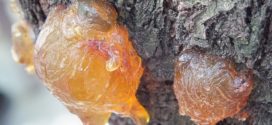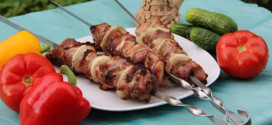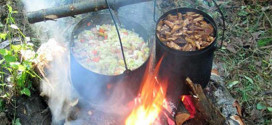Dried meat is a universal product, the preparation of which should be mastered by every tourist, hunter and fisherman. Initially, drying served solely to preserve the uneaten parts of the carcass. Today, it can be a great way to prepare food for a trip or create a meat delicacy worthy of any holiday table.
Content
Methods for drying meat
The best way to make dry meat that retains a maximum of useful and gustatory properties is sublimation. During this process, the product is rapidly frozen at very low temperature and reduced pressure. Under such conditions, ice crystals pass into the gaseous state, bypassing the liquid phase.
Sublimates have practically no weight, they are stored for a long time. However, it is impossible to make such a blank at home, because this requires special equipment.
At home, you can cook jerky or dried meat with your own hands. Both options allow you to preserve the product for a while and use it as needed. The difference is that withering removes only a fraction of the moisture, so cured meat has a limited shelf life. In this way, various delicacies are usually prepared - basturma, biltong, jamon, etc.
Dried meat cannot be called a delicacy, it is usually used for quick recovery when there is no way to cook something, or as an addition to other dishes. But it can be stored indefinitely. In addition, like freeze-dried meat, it is very light and takes up little space, making it the best food option for tourists.
What is needed for cooking?
To dry meat at home, no special meat dryer is required. You can get different types of such a product by cooking them in a conventional oven or in an electric dryer. And if you have time, patience and a well-ventilated room without flies, you can achieve excellent results without any equipment at all.
Having figured out how to dry meat, you need to understand what the product itself should be like. Beef and lamb are suitable, sometimes chicken is used. There are many dry-cured pork delicacies on sale. But it is better not to dry pork at home, as it is more prone to colonization by microorganisms than other varieties. The product must be fresh, of high quality, without bones, films, cartilage, veins and pieces of fat.
For the preparation of the dried version, you can not use anything else. Although salt, pepper, various herbs are often added for taste. A dried product will definitely require spices and spices that work not only as flavor enhancers, but also as preservatives. Often fenugreek, coriander, chili are used for this.
Jerky
Almost all peoples have recipes for cooking such meat with their own hands. Today, among the most popular are basturma (Turkic origin) and biltong (African).
Basturma
To treat yourself to basturma, take a fresh beef tenderloin and stock up on chaman (fenugreek seeds). Rinse the beef, pat dry and season thoroughly with salt. Leave for 7-10 days in the refrigerator, turning daily and adding dry salt to the bare places. When the tenderloin becomes dry and hard to the touch, rinse it, hold it overnight in cold water and put it under the press for a day.
In the meantime, pour 600 g of ground fenugreek seeds into warm water until the consistency of thick sour cream is obtained. Leave overnight. Squeeze 300 g of garlic into the mixture, add 150 g of ground chili and paprika each. Mix well, add water if necessary. Remove the beef from under the press, completely coat with pasta with a layer no thinner than 0.5 cm.
There is no single answer to the question of how to properly dry meat prepared in this way. You can lightly hold it in the oven to dry the pasta, and then hang it in a cool place. You can immediately hang it, given that the paste may initially drain and drip a little.
In any case, bare spots will need to be sealed. Therefore, do not throw away the paste left after the initial coating of the delicacy. Basturma will be ready after 2-4 weeks, when the paste hardens and the meat inside becomes dark.
Biltong
This option is faster and easier to prepare. Mix 2 tbsp. l. salt, 1 tbsp. l. ground coriander, 1 tsp. sugar and ground black pepper. Wash 1 kg of meat, dry it, cut it along the fibers into strips no more than 1 cm thick. Beat them lightly, sprinkle with 6% vinegar, sprinkle with the mixture on all sides, put in a stainless steel container, set oppression and place in the cold for 12 hours.
Dilute 6% vinegar with clean water in a ratio of 1:6. Place the meat in the solution for 5 minutes, thoroughly rinse each piece in it and hang it in a well-ventilated place for about a day.
Cut the finished pieces into thin strips across the fibers and enjoy.
The classic recipe for basturma involves the use of beef. You can improvise with biltong. The inhabitants of Africa made such a dish from any available meat, even from elephant meat. In modern conditions, both dried beef and dried lamb will be equally tasty.
dried meat
The question of how to make dried meat is even easier. There are 2 main ways:
The first recipe involves drying the product with plates. Slice fresh meat across the grain into very thin slices. The value depends on the further use. If dried beef or lamb is needed for storage and subsequent cooking, the slices can be of any size.
If you intend to snack on the dried meat itself, without cooking it, it is better to make the pieces smaller so that it is convenient to take them in your mouth and chew them whole. Before drying the sliced slices, you can hold them for a day in a brine made to your taste.
The second recipe is more suitable for harvesting a long-term storage product. Scroll fresh meat in a meat grinder, spread it in a thin layer on an oven tray or dryer tray and cook until crackers. If desired, minced meat can be salted and peppered. During drying, it is worth loosening it from time to time for more uniform evaporation of moisture.
Whichever drying option you choose, remember that there are certain rules for preparing and storing the product that must be observed.
Basic Rules
The basic rules for the preparation of dried and dried meat include the following:
- When meat is to be cured or air-dried, the room should be cool, shaded and well ventilated. If there is no certainty that insects will not get to the meat, it is better to cover it with gauze or a thin cloth made from natural fibers.
- Dried meat in the oven should be cooked at a temperature not lower than +60 and not higher than +70 ° C with the door ajar for about 4 hours. Lay the pieces on a wire rack, place a tray down so that the juice dripping from the meat does not stain the oven. If the stove is gas, they heat it up, turn it off, and only then put the meat. As the meat cools, they take it out, heat the oven again, turn off the gas and put the product back in. If you need not to dry, but to dry the meat, it may take up to 24 hours.
- A dryer for drying is not the most suitable device, since the product is easy to overdry. Therefore, cook dried meat in the dryer only under supervision. Lay out the pieces on pallets so that there is a gap of several millimeters between them for better moisture removal. If you stack several pallets on top of each other, put the thicker pieces on the lower level.
Different types of harvested meat have their own storage characteristics. For example, dried after processing must be laid out on clean paper in 1 layer and left for a day. This will allow any remaining moisture to evaporate. If the content of dried meat in the dark, without access to moisture, it can remain suitable for consumption for as long as you like at any temperature.
How to store jerky depends, among other things, on the method of preparation. For example, basturma covered with a layer of spices can simply be wrapped in parchment. Biltong, in such conditions, will continue to dry out. Therefore, it is better to put it in a glass container and close it tightly.
The main thing is that the jerky is kept in a cool place. If it is stored at room temperature, it should be eaten within 2 weeks. And at the slightest suspicion of a change in taste or smell, it is better to refuse to use it or subject it to additional heat treatment.
Hello, I am Alexander, the mastermind behind the blog.
In terms of career and free time, I connected my life with the forest. How else, when you live in Karelia! In this blog, I am responsible for the hunting, hiking and equipment sections. Welcome to my world!
 Survival Lessons Tips for the survivalist, fisherman and hunter
Survival Lessons Tips for the survivalist, fisherman and hunter



The causative agent of botulism is an anaerobic bacterium and does not develop with air access.